This is the second chapter of behind the scenes of Visual Effects Movies. Check out some more technological enhancements behind Hollywood’s block buster VFX movies.
Don’t miss out >>> Complete series of Visual Effects movies making process:
How Hollywood makes High Quality Block Buster VFX Movies so Fast? – Part 1
How Hollywood makes High Quality Block Buster VFX Movies so Fast? – Part 3
How Hollywood makes High Quality Block Buster VFX Movies so Fast? – Part 4
2) 3D Camera Projection:
It is also known as ‘Camera Mapping’. This is the ultimate tool of Matte painting artists, Animators and Compositors. Without any doubt, this is the most kick ass technique Hollywood had adapted in recent years.
Before this, modellers and texturing artists were creating massive work for the CG objects. But why to waste expensive time and money for the work which is not seen by the camera? 3D Camera Projection is the solution for this. 3D Camera Projection is the replacement of working with full cg geometry with complete shading, texturing and lighting.
In this technique, 2D flat image is projected on 3D geometry. The 3D geometry is built accurately with reference of actual width, height and depth of 2D image (character / prop). This methodology gives convincing 3D depth even when the camera is orbiting. This technique works very well with irregular shaped objects also. The texture is placed on the CGI geometry as per the camera animation, so you can omit so many unwanted production works. In turn, it increases the production speed on the very large scale. In VFX post production pipeline, Blackmagic Design Fusion and Foundry NUKE are the most widely used packages for projection mapping.
Following are the most common visual effects movies sequences where camera projection is used:
- VFX Destruction shot in metro cities
- Desert, Mountain lines, Vast horizon type nature shots
- Chasing shots of human characters / CGI elements
- Moving cameras in matte paintings (3D matte paintings)
- Creating a surreal / natural environment in low cost
3) Motion Capture (MoCap) for Visual Effects movies:
It is also referred as ‘performance capture’.
Typical 3D Animation is very lengthy process. It requires so many pre activities like extreme rig testing, skin binding, deformation of joints etc. After this, each character needs to be animated separately. It becomes much more complex when the CGI characters are having inter actions shots. To save this massive production time and money, Motion Capture got invented. In the current scenario, it is used in every major Visual Effects movies.
It is the technology where the motion capture artist wears a special kind of suit. The suit is equipped with sensors and markers. Every physical behaviour is captured by cameras and lighting effects. These actions are directly captured to 3D Animation package. The CG animator can fine tune or exaggerate the animation. Recorded MoCap animations can be tweaked as per the client requirement. To get the detailed facial expression, multiple sensors are placed on the face of motion capture artist. Apart from human beings, it can also be used to transfer movement of real animals to CGI animals.
In recent developments, Apple Acquired Faceshift, the Motion Capture Firm for Virtual Reality (VR) Developments.
Gollum from LOTR (Lord of The Rings) was the first complete Mo-cap character of live action movie. Na’vis from AVATAR will always be remarkable in the field of motion capture technology. The list of some other notable motion captured CG and VFX movie characters and the performance artists are as follows:
- Davey Jones (Pirates of the Caribbean) – Bill Nighy
- Hulk – Mark Ruffalo
- Dragon (The Hobbit: The Desolation of Smaug) – Benedict Cumberbatch
- Caesar (Rise of the Planer of the Apes, Dawn of the Planet of the Apes) – Andi Serkis
- Polar Express – Tom Hanks
- Gollum, King Kong – Andi Serkis
Enjoy amazing motion capture of Coldplay’s music video ‘Adventure of a Lifetime’







